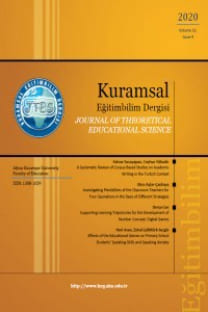Psychometric analysis of the Interpersonal Sensitivity Measure (IPSM) among Turkish undergraduate students
Kişilerarası duyarlılık ölçeğinin Türk Üniversite öğrencilerinde psikometrik analizi
___
- Ayduk, O., Downey, G., Testa, A., Yen, Y., & Shoda, Y. (1999). Does rejection elicit hostility in high rejection sensitive women? Social Cognition, 17, 245-271.
- Beck, A. T., Steer, R. A., & Garbin, M. G. (1988). Psychometric properties of the Beck depression inventory: twenty-five years of evaluation. Clinical Psychology Review, 8, 77-100.
- Boyce, P. & Mason, C. (1996). An overview of depression-prone personality traits and the role of interpersonal sensitivity. Australian and New Zealand Journal of Psychiatry, 30, 90-103.
- Boyce, P. & Parker, G. (1989). Development of a scale to measure interpersonal sensitivity. Australian and New Zealand Journal of Psychiatry, 23, 341-351.
- Boyce, P., Hickie, I., Parker, G., & Mitchell, P. (1993). Specificity of interpersonal sensitivity to nonmelancholic depression. Journal of Affective Disorders, 27, 101-105.
- Boyce, P., Hickie, I., Parker, G., Mitchell, P., Wilhelm, K., & Brodaty, H. (1992). Interpersonal sensitivity and the one-year outcome of a depressive episode. Australian and New Zealand Journal of Psychiatry, 26, 156-161.
- Butler, J. C., Doherty, M. S., & Potter, R. M. (2007). The social antecedents and consequences of interpersonal rejection sensitivity. Personality and Individual Differences, 43, 1376-1385.
- Byrne, B. M. & Campbell, T. L. (1999). Cross-cultural comparisons and the presumption of equivalent measurement and theoretical structure: a look beneath the surface. Journal of Cross-Cultural Psychology, 30, 555-574.
- Davidson, J. R., Zisook, S., Giller, E., & Helms, M. (1989). Symptoms of interpersonal sensitivity in depression. Comprehensive Psychiatry, 30, 357-368.
- Derogatis, L. R., Lipman, R. S., & Covi, L. (1973). SCL-90: an outpatient psychiatric rating scalepreliminary report. Psychopharmacology Bulletin, 87, 49-74.
- Diener, E., Emmons, R. A., Larsen, R. J., & Griffin, S. (1985). The satisfaction with life scale. Journal of Personality Assessment, 49, 71-75.
- Doğan, T. & Çetin, B. (2009). Tromso sosyal zeka ölçeği Türkçe formunun faktör yapısı: geçerlik ve güvenirlik çalışması. Kuram ve Uygulamada Eğitim Bilimleri, 9(2), 691-720.
- Erözkan, A. (2005). Üniversite öğrencilerinin kişilerarası duyarlılık ve depresyon düzeylerinin bazı değişkenlere göre incelenmesi. Muğla Üniversitesi Sosyal Bilimler Enstitüsü Dergisi, 14, 129-155.
- Gençdoğan, B. (2001). Zung depresyon ölçeğinin üniversite öğrencileri için geçerlik güvenirliği ile faktör yapısı. Yayımlanmamış yüksek lisans tezi, Atatürk Üniversitesi, Erzurum, Türkiye.
- Gilboa-Schechtman, E., Foa, E., Vaknin, Y., Marom, S., & Hermesh, H. (2008). Interpersonal sensitivity and response bias in social phobia and depression: labeling emotional expressions. Cognitive Therapy and Research, 32, 605–618.
- Harb, G. C., Heimberg, R. G., Fresco, D. M., Schneier, F. R., & Liebowitz, M. R. (2002). The psychometric properties of the interpersonal sensitivity measure in social anxiety disorder. Behaviour Research and Therapy, 40, 961–979.
- Hooper, D., Coughlan, J., & Mullen, M. (2008). Structural equation modeling: guidelines for determining model fit. The Electronic Journal of Business Research Methods, 6(1), 53-60.
- Köker, S. (1991). Normal ve sorunlu ergenlerin yaşam doyumu düzeylerinin karşılaştırılması. Yayımlanmamış yüksek lisans tezi, Ankara Üniversitesi, Ankara, Türkiye.
- London, B., Downey, G., Bonica, C., & Paltin, I. (2007). Social causes and consequences of rejection sensitivity. Journal of Research on Adolescence, 17(3), 481-506
- Marlowe, H. A. (1986). Social intelligence: evidence for multidimensionality and construct independence. Journal of Educational Psychology, 78(1), 52-58.
- Marsh, H. W., Hau, K.T., Artelt, C., Baumert, J., & Peschar, J. L. (2006). OECD’s brief self-report measure of educational psychology’s most useful affective constructs: cross-cultural, psychometric comparisons across 25 countries. International Journal of Testing, 6(4), 311-360.
- Mattick, R. P. & Clarke, J. C. (1998). Development and validation of measures of social phobia scrutiny fear and social interaction anxiety. Behaviour Research and Therapy, 36, 455-470.
- Reiss, S., Peterson, R. A., Gursky, D. M., & McNally, R. J. (1986). Anxiety sensitivity, anxiety frequency and the predictions of fearfulness. Behaviour Research and Therapy, 24, 1-8.
- Rizzo, C. J., Daley, S. E., & Gunderson, B. H. (2006). Interpersonal sensitivity, romantic stress, and the prediction of depression: a Study of inner-city, minority adolescent girls. Journal of Youth and Adolescence, 35(3), 469–478.
- Sapmaz, F. (2011). Bilişsel davranışçı yaklaşıma dayalı grupla psikolojik danışmanın sosyal anksiyete, reddedilme duyarlılığı ve kişilerarası duyarlılık üzerine etkisi. Yayımlanmamış doktora tezi, Sakarya Üniversitesi, Sakarya, Türkiye.
- Schumacker, R. E. & Lomax, R. G. (2004). A beginner's guide to structural equation modeling. NJ: Lawrence Erlbaum.
- Silvera, D. H., Martinussen, M., & Dahl, T. I. (2001). The Tromso social intelligence scale, a self-report measure of social intelligence. Scandinavian Journal of Psychology, 42, 313-31.
- Stafford, L. (2007). Interpersonal rejection sensitivity: toward exploration of a construct. Issues in Mental Health Nursing, 28, 359-372.
- Şimşek, Ö. F. (2008). Yapısal eşitlik modellemesine giriş: temel ilkeler ve Lisrel uygulamaları. Ankara: Ekinoks Yayıncılık.
- Thorndike, E. L. (1920). Intelligence and its use. Harpers Magazine, 140, 227-235.
- Vidyanidhi, K. & Sudhir, P. M. (2009). Interpersonal sensitivity and dysfunctional cognitions in social anxiety and depression. Asian Journal of Psychiatry, 2, 25-28
- Wilhelm, K., Boyce, P., & Brownhill, S. (2004). The relationship between interpersonal sensitivity, anxiety disorders and major depression. Journal of Affective Disorders, 79, 33-4.
- Yüksel, G. (1997). Sosyal beceri eğitiminin üniversite öğrencilerinin sosyal beceri düzeyine etkisi. Yayımlanmamış doktora tezi, Gazi Üniversitesi, Ankara, Türkiye.
- Zung, W.W. K. (1965). A self-rating depression scale. Archive General Psychiatry, 12, 63-70.
- ISSN: 1308-1659
- Yayın Aralığı: 4
- Başlangıç: 2008
- Yayıncı: Afyon Kocatepe Üniversitesi Eğitim Fakültesi
An investigation of the effective leadership behaviors of school principals
Anaokuluna Devam Eden Çocukların Yaratıcılıklarının İncelenmesi
Zuhal Gizir Ergen, Aysel Köksal Akyol
Öğretmen Adaylarının Öğretmen Kişilik Özelliklerine Yönelik Algılarının İncelenmesi
Nurettin ÖZGEN, Mustafa KAHYAOĞLU
Mustafa Kahyaoğlu, Nurettin Özgen
An investigation of pre-service teachers’ perceptions of teacher personality characteristics
Okul Müdürlerinin Etkili Liderlik Davranışlarının İncelenmesi
